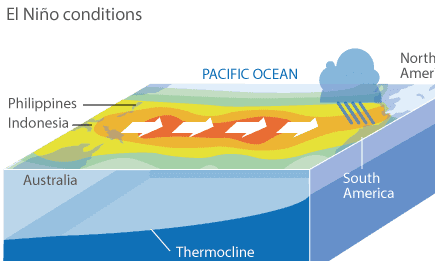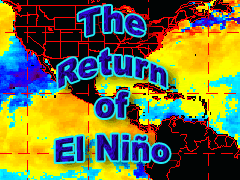Some of the climatic phenomena of recent years were the consequence of El Niña over the Pacific Ocean that appeared in 2020, which had an abnormally long longevity but which should end between March and May 2023. This climate phenomenon will be replaced by the opposite phenomenon, El Niño, which is expected to return between the fall and winter of 2023 and peak in 2024.
While El Niña is characterized by abnormally cold waters in the Central Pacific Ocean and a transfer of heat from the atmosphere to the ocean, El Niño is characterized by abnormally warm waters off the coast of South America and a transfer of heat from the ocean to the atmosphere.
The return of El Niño is expected to coincide with the return of abnormally warm temperatures, as the temperatures of the last three years have been tempered by the presence of El Niña.
So far, the warmest year on record was 2016, during the last El Niño climate event. If the return of El Niño is confirmed, it should cause the Pacific Ocean to warm up at the end of 2023 and the year 2024 could become the new reference in terms of record heat. Scientist Paloma Trascasa-Castro tells The Conversation that the planet has already warmed by about 1.2˚C compared to the pre-industrial era and that El Niño adds some extra heat to the atmosphere, it is possible that the Earth will temporarily exceed the 1.5˚C threshold set by the Paris agreements shortly after El Niño peaks in 2024, it will depend on the intensity of the phenomenon.

But the consequences of El Niño are not limited to the increase in global average temperature, the main weather phenomena of lows and highs are reorganizing in a pattern that strongly influences regional hydrology and consequently, agriculture and the occurrence of diseases such as dengue or malaria.
The Amazon, South Africa, Australia and Indonesia are more prone to droughts and fires, while East Africa, southern North America and South America, especially Peru and Ecuador, are more prone to rainfall and flooding. Because large tropical forests receive less precipitation, El Niño years are generally associated with spikes in atmospheric carbon dioxide levels. Outside the tropics, El Niño facilitates the transfer of cold air masses to lower latitudes, particularly in northern Europe. If these effects remain relative, it is nevertheless possible that a more important cold will settle on certain regions of Europe next winter.



Comment here